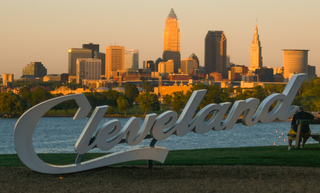
Cleveland, officially the City of Cleveland, is a city in the U.S. state of Ohio and the county seat of Cuyahoga County. Located in Northeast Ohio along the southern shore of Lake Erie, it is situated across the U.S. maritime border with Canada and lies approximately 60 miles (97 km) west of Pennsylvania. Cleveland ranks as the most populous city on Lake Erie, the second-most populous city in Ohio, and the 54th-most populous city in the U.S. with a 2020 population of 372,624. The city anchors the Cleveland metropolitan area, the 33rd-largest in the U.S. at 2.18 million residents, as well as the larger Cleveland–Akron–Canton combined statistical area, the most populous in Ohio and the 17th-largest in the country with a population of 3.63 million in 2020.
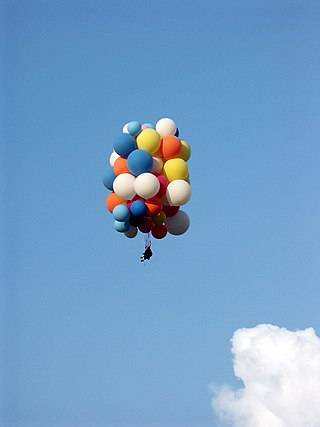
On July 2, 1982, Larry Walters made a 45-minute flight in a homemade aerostat made of an ordinary patio chair and 45 helium-filled weather balloons. The aircraft rose to an altitude of about 16,000 feet (4,900 m), drifted from the point of liftoff in San Pedro, California, and entered controlled airspace near Long Beach Airport. During the final descent, the aircraft became entangled in power lines, but Walters was able to climb down safely. The flight attracted worldwide media attention and inspired a movie and numerous imitators.

George Victor Voinovich was an American politician who served as a United States senator from Ohio from 1999 to 2011. He previously served as the 65th governor of Ohio from 1991 to 1998 and as the 54th mayor of Cleveland from 1980 to 1989, the last Republican to serve in that office.

Richfield Coliseum, also known as the Coliseum at Richfield, was an indoor arena located in Richfield Township, between Cleveland and Akron, Ohio. It opened in 1974 as a replacement for the Cleveland Arena, and had a seating capacity of 20,273 for basketball. It was the main arena for the Northeast Ohio region until 1994, when it was replaced by Gund Arena in downtown Cleveland. The Coliseum stood vacant for five years before it was purchased and demolished in 1999 by the National Park Service. The site of the building was converted to a meadow and is now part of Cuyahoga Valley National Park.

Cleveland Burke Lakefront Airport is a city-owned airport on the shore of Lake Erie, in the northeast part of downtown Cleveland, Ohio, United States. It's classified as a general aviation airport and is an FAA designated reliever to Cleveland Hopkins International Airport (CLE), which is Greater Cleveland's primary airport. In 2018, based on FAA data, Burke Lakefront was the seventh busiest airport in the state of Ohio. It is named after former Cleveland mayor and U.S. senator Thomas A. Burke.

Cluster ballooning is an extreme sport and a form of ballooning where a harness attaches a balloonist to a cluster of helium-inflated rubber balloons.

Public Auditorium is a multi-purpose performing arts, entertainment, sports, and exposition facility located in the civic center district of downtown Cleveland, Ohio. The 10,000-capacity main auditorium shares its stage with a second venue housed at the facility: the 3,000-capacity Music Hall. Although Public Auditorium was planned and funded prior to World War I, construction did not begin until 1920, and the building did not open until 1922. Designed by city architect J. Harold McDowell and Frank Walker of Walker and Weeks in a neoclassical style matching the other Group Plan buildings, it was the largest of its kind when opened, then seating 11,500.

The Justice Center Complex is a building complex located in the Civic Center District in Cleveland, Ohio, in the United States. The complex consists of the Cleveland Police Headquarters Building, the Cuyahoga County and Cleveland Municipal Courts Tower, and the Correction Center, and Jail II. It occupies a city block bounded by Lakeside Avenue, Ontario Street, West 3rd Street, and St. Clair Avenue. The Lakeside Avenue entrance faces the Cuyahoga County Court House, erected in 1912.

Public Square is the central plaza of Downtown Cleveland, Ohio. Based on an 18th-century New England model, it was part of the original 1796 town plat overseen by city founder General Moses Cleaveland of the Connecticut Land Company. The historical center of the city's downtown, it was added to the National Register of Historic Places in 1975.
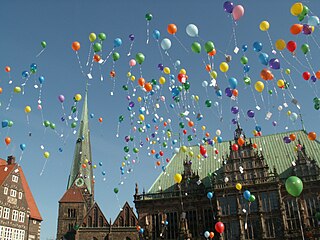
A balloon release is a ceremonial event in which a number of hydrogen- or helium-filled balloons are launched into the sky. Balloon releases can be done as a prayer ceremony, to create a photo opportunity, to raise awareness of a cause or campaign, or as a competitive long-distance race.
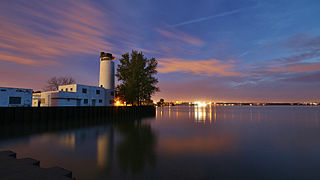
Whiskey Island is a peninsula at the mouth of the Cuyahoga River at Lake Erie in Cleveland, Ohio. Its current configuration was created in 1827 when the river's mouth was moved to its present location. Part of the city's Cuyahoga Valley neighborhood, the peninsula is 1 mile (1.6 km) long and 0.3 miles (0.48 km) at its widest, bounded by Lake Erie to the north, West 54th Street on the west (roughly), and the Cuyahoga River to the south and east.

The James A. Garfield Memorial is a memorial for and the final resting place of assassinated President James A. Garfield, located in Lake View Cemetery in Cleveland, Ohio. The memorial, which began construction in October 1885 and was dedicated on May 30, 1890, exhibits a combination of Byzantine, Gothic, and Romanesque Revival architectural styles. Garfield, former First Lady Lucretia Garfield, and two other members of the Garfield family are entombed in the crypt level of the monument.

A balloon is a flexible membrane that can be inflated with a gas, such as helium, hydrogen, nitrous oxide, oxygen, and air. For special tasks, balloons can be filled with smoke, liquid water, granular media, or light sources. Modern day balloons are made from materials such as rubber, latex, polychloroprene, or a nylon fabric, and can come in many different colors. Some early balloons were made of dried animal bladders, such as the pig bladder. Some balloons are used for decorative purposes or entertaining purposes, while others are used for practical purposes such as meteorology, medical treatment, military defense, or transportation. A balloon's properties, including its low density and low cost, have led to a wide range of applications.
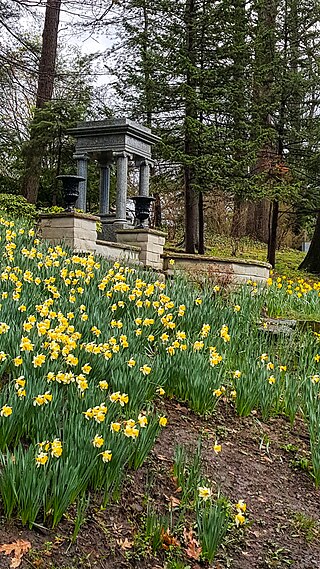
Lake View Cemetery is a privately owned, nonprofit garden cemetery located in the cities of Cleveland, Cleveland Heights, and East Cleveland in the U.S. state of Ohio. Founded in 1869, the cemetery was favored by wealthy families during the Gilded Age, and today the cemetery is known for its numerous lavish funerary monuments and mausoleums. The extensive early monument building at Lake View helped give rise to the Little Italy neighborhood, but over-expansion nearly bankrupted the burial ground in 1888. Financial recovery only began in 1893, and took several years. Lake View grew and modernized significantly from 1896 to 1915 under the leadership of president Henry R. Hatch. The cemetery's cautious management allowed it to avoid retrenchment and financial problems during the Great Depression.
On the morning of February 27, 2012, six students were shot at Chardon High School in Chardon, Ohio, resulting in the deaths of three of them. Witnesses said that the shooter had a personal rivalry with one of his victims. Two other wounded students were also hospitalized, one of whom sustained several serious injuries that have resulted in permanent paralysis. The fifth student suffered a minor injury, and the sixth a superficial wound.
This is a list of notable events relating to the environment in 1986. They relate to environmental law, conservation, environmentalism and environmental issues.

Between 2002 and 2004, Ariel Castro abducted Michelle Knight, Amanda Berry, and Gina DeJesus from the roads of Cleveland, Ohio and later held them captive in his home at 2207 Seymour Avenue in the city's Tremont neighborhood. All three young women were imprisoned at Castro's home until 2013, when Berry successfully escaped with her six-year-old daughter, to whom she had given birth while captive, and contacted the police. Police rescued Knight and DeJesus, and arrested Castro hours later.

The Cleveland Foundation Centennial Lake Link Trail, originally known as the Lake Link Trail, is a cycling, hiking, and walking trail located in the city of Cleveland, Ohio, in the United States. Owned by the city of Cleveland and maintained by Cleveland Metroparks, the trail runs along the former track bed of the Cleveland and Mahoning Valley Railroad. The trail is named for The Cleveland Foundation, a local community foundation which donated $5 million toward the trail's construction. The southern leg of the 1.3-mile (2.1 km) trail opened in August 2015, and the northern leg in August 2017. The middle leg will begin construction once the Irishtown Bend hillside is stabilized. A bridge connecting the trail to Whiskey Island will begin construction in Spring 2019 and will be completed in early Summer 2020.
Balloonfest is a 2017 documentary short film by Nathan Truesdell.















